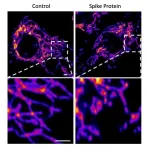(Press-News.org) Boston, MA (April 30, 2021) - A new study, presented today at the AATS 101st Annual Meeting, shows that non-invasive cell-free DNA tests can reduce the need for regular surveillance biopsies to detect early rejection in heart transplant patients. The study was the first of its kind to be performed on both adult and pediatric patients.
Pediatric and adult heart transplant recipients were recruited prospectively from eight participating sites and followed longitudinally for at least 12 months with serial plasma samples collected immediately prior to all endomyocardial biopsies. Structured biopsy results and clinical data were collected and monitored by an independent clinical research organization (CRO).
For all patients taken together in comparison to the composite biopsy outcome using repeated measures, donor fraction (DF) cfDNA at a pre-defined cut point of 0.14 had a sensitivity of 67%, a specificity of 79%, a PPV of 34% and a NPV of 94% with an area under the curve (AUC) of 0.78 (p END
Clinically viable blood test for donor-derived cell-free DNA
Can vastly reduce the need for routine surveillance biopsies following heart transplantation
2021-04-30
ELSE PRESS RELEASES FROM THIS DATE:
Study finds similar long-term outcomes for mechanically-ventilated COVID-19 patients
2021-04-30
Boston, MA (April 30, 2021) - A new study, presented today at the AATS 101st Annual Meeting, found that severely ill COVID-19 patients treated with ECMO did not suffer worse long-term outcomes than other mechanically-ventilated patients. The multidisciplinary team included cardio thoracic surgeons, critical care doctors, medical staff at long-term care facilities, physical therapists and other specialists, and followed patients at five academic centers: University of Colorado; University of Virginia; University of Kentucky; Johns Hopkins University; and Vanderbilt University. ...
The novel coronavirus' spike protein plays additional key role in illness
2021-04-30
LA JOLLA--(April 30, 2021) Scientists have known for a while that SARS-CoV-2's distinctive "spike" proteins help the virus infect its host by latching on to healthy cells. Now, a major new study shows that they also play a key role in the disease itself.
The paper, published on April 30, 2021, in Circulation Research, also shows conclusively that COVID-19 is a vascular disease, demonstrating exactly how the SARS-CoV-2 virus damages and attacks the vascular system on a cellular level. The findings help explain COVID-19's wide variety of seemingly unconnected complications, and could ...
Move over CRISPR, the retrons are coming
2021-04-30
While the CRISPR-Cas9 gene editing system has become the poster child for innovation in synthetic biology, it has some major limitations. CRISPR-Cas9 can be programmed to find and cut specific pieces of DNA, but editing the DNA to create desired mutations requires tricking the cell into using a new piece of DNA to repair the break. This bait-and-switch can be complicated to orchestrate, and can even be toxic to cells because Cas9 often cuts unintended, off-target sites as well.
Alternative gene editing techniques called recombineering instead perform this bait-and-switch ...
Decoding the effect of body mass index on breast cancer
2021-04-30
Medical researchers at Flinders University have established a new link between high body mass index (BMI) and breast cancer survival rates - with clinical data revealing worse outcomes for early breast cancer (EBC) patients and improved survival rates in advanced breast cancer (ABC).
In a new study published in a top breast cancer journal- researchers evaluated data from 5 thousand patients with EBC and 3496 with ABC to determine associations between BMI and survival rates across both stages.
Researchers say the results present an 'obesity paradox' which will impact the survival outcomes of the 19,807 women and 167 men diagnosed with breast cancer in Australia in 2020.
Natansh Modi, a NHMRC PHD Candidate at Flinders University, says understanding the ...
Brazilian Amazon released more carbon than it stored in 2010s
2021-04-30
The Brazilian Amazon rainforest released more carbon than it stored over the last decade - with degradation a bigger cause than deforestation - according to new research.
More than 60% of the Amazon rainforest is in Brazil, and the new study used satellite monitoring to measure carbon storage from 2010-2019.
The study found that degradation (parts of the forest being damaged but not destroyed) accounted for three times more carbon loss than deforestation.
The research team - including INRAE, the University of Oklahoma and the University of Exeter - said large areas of rainforest were degraded or destroyed due to human activity and climate change, leading to carbon loss.
The findings, published in Nature Climate Change, also ...
DNA building blocks regulate inflammation
2021-04-30
Mitochondria are the energy suppliers of our body cells. These tiny cell components have their own genetic material, which triggers an inflammatory response when released into the interior of the cell. The reasons for the release are not yet known, but some cardiac and neurodegenerative diseases as well as the ageing process are linked to the mitochondrial genome. Researchers at the Max Planck Institute for Biology of Ageing and the CECAD Cluster of Excellence in Ageing research have investigated the reasons for the release of mitochondrial genetic material and found a direct link to cellular metabolism: when the cell's DNA building blocks are in short supply, mitochondria release their genetic material and trigger inflammation. ...
World's first fiber-optic ultrasonic imaging probe for future nanoscale disease diagnostics
2021-04-30
Scientists at the University of Nottingham have developed an ultrasonic imaging system, which can be deployed on the tip of a hair-thin optical fibre, and will be insertable into the human body to visualise cell abnormalities in 3D.
The new technology produces microscopic and nanoscopic resolution images that will one day help clinicians to examine cells inhabiting hard-to-reach parts of the body, such as the gastrointestinal tract, and offer more effective diagnoses for diseases ranging from gastric cancer to bacterial meningitis.
The high level of performance the technology delivers is currently only possible in state-of-the-art research labs with large, scientific instruments - whereas this compact system has the potential to bring it into clinical settings to improve patient care.
The ...
Navigating the squircle
2021-04-30
Successful navigation requires the ability to separate memories in a context-dependent manner. For example, to find lost keys, one must first remember whether the keys were left in the kitchen or the office. How does the human brain retrieve the contextual memories that drive behavior? J.B. Julian of the Princeton Neuroscience Institute at Princeton University, USA, and Christian F. Doeller of the Max Planck Institute for Human Cognitive and Brain Sciences in Leipzig, Germany, found in a recent study that modulation of map-like representations in our brain's hippocampal formation can predict contextual memory retrieval in an ambiguous environment.
The researchers developed a novel virtual reality navigation task in which human participants learned object positions in two different ...
Awake brings proton bunches into sync
2021-04-30
The future of particle acceleration has begun. Awake is a promising concept for a completely new method with which particles can be accelerated even over short distances. The basis for this is a plasma wave that accelerates electrons and thus brings them to high energies. A team led by the Max Planck Institute for Physics now reports a breakthrough in this context. For the first time, they were able to precisely time the production of the proton microbunches that drive the wave in the plasma. This fulfills an important prerequisite for using the Awake technology for collision experiments.
How do you create a wave for electrons? The carrier substance for this is a plasma (i.e., an ionized gas in which positive and negative charges are separated). Directing a proton beam through ...
Important factor in the development of dendritic cells identified
2021-04-30
The human immune system comprises functionally specialised cellular defence mechanisms that protect the body against disease. These include the dendritic cells. Their main function is to present antigens to other immune cells, especially T cells, thereby activating a primary immune response. Dendritic cells are divided into Type 1 (DC1) and Type 2 (DC2) dendritic cells. Each type fulfils different functions: DC1 provide an immune response to bacteria and viruses, DC2 protect against fungal or parasitic infections. In a recent study conducted at MedUni Vienna's Institute of Cancer Research, researchers found that a particular group of proteins plays a major role in the development of Type 1 dendritic ...
LAST 30 PRESS RELEASES:
Why nail-biting, procrastination and other self-sabotaging behaviors are rooted in survival instincts
Regional variations in mechanical properties of porcine leptomeninges
Artificial empathy in therapy and healthcare: advancements in interpersonal interaction technologies
Why some brains switch gears more efficiently than others
UVA’s Jundong Li wins ICDM’S 2025 Tao Li Award for data mining, machine learning
UVA’s low-power, high-performance computer power player Mircea Stan earns National Academy of Inventors fellowship
Not playing by the rules: USU researcher explores filamentous algae dynamics in rivers
Do our body clocks influence our risk of dementia?
Anthropologists offer new evidence of bipedalism in long-debated fossil discovery
Safer receipt paper from wood
Dosage-sensitive genes suggest no whole-genome duplications in ancestral angiosperm
First ancient human herpesvirus genomes document their deep history with humans
Why Some Bacteria Survive Antibiotics and How to Stop Them - New study reveals that bacteria can survive antibiotic treatment through two fundamentally different “shutdown modes”
UCLA study links scar healing to dangerous placenta condition
CHANGE-seq-BE finds off-target changes in the genome from base editors
The Journal of Nuclear Medicine Ahead-of-Print Tip Sheet: January 2, 2026
Delayed or absent first dose of measles, mumps, and rubella vaccination
Trends in US preterm birth rates by household income and race and ethnicity
Study identifies potential biomarker linked to progression and brain inflammation in multiple sclerosis
Many mothers in Norway do not show up for postnatal check-ups
Researchers want to find out why quick clay is so unstable
Superradiant spins show teamwork at the quantum scale
Cleveland Clinic Research links tumor bacteria to immunotherapy resistance in head and neck cancer
First Editorial of 2026: Resisting AI slop
Joint ground- and space-based observations reveal Saturn-mass rogue planet
Inheritable genetic variant offers protection against blood cancer risk and progression
Pigs settled Pacific islands alongside early human voyagers
A Coral reef’s daily pulse reshapes microbes in surrounding waters
EAST Tokamak experiments exceed plasma density limit, offering new approach to fusion ignition
Groundbreaking discovery reveals Africa’s oldest cremation pyre and complex ritual practices
[Press-News.org] Clinically viable blood test for donor-derived cell-free DNACan vastly reduce the need for routine surveillance biopsies following heart transplantation





